
"Baby Reindeer” isn’t merely well told. It’s well-made, too.
That’s all owing to Mekel Bailey, the costume designer behind the looks featured in Netflix’s hugely popular limited series that explores dark themes: stalking, sexual abuse and depression. In the series, comedian Richard Gadd plays a fictionalized version of himself, Donny Dunn, a struggling comedian with a traumatic past who is stalked by Martha (Jessica Gunning), a woman he meets at the pub he works at in London.
Gadd’s comedic prowess assists in cutting through some of the weightier content, while Bailey’s assemblage of carefully curated costumes brings the show to life, visually speaking. In a show that’s so incredibly steeped in its characters’ inner worlds, Bailey’s thoughtful costuming choices serve to reflect just that. From the emotional resonance of color palettes to the drawn-out process of sourcing clothes — some of which came from the closets of Bailey’s family and friends — his expertise lent not only a critical and creative eye to the show but a sensitive one as well.
Bailey spoke to Salon about his creative process and vision for "Baby Reindeer's" looks, and why Gunning enjoyed wearing his grandmother’s sweaters.
This interview has been edited for clarity and length.
What were the conversations about costuming when you were first brought on to "Baby Reindeer"? Did you speak to Richard Gadd? How familiar were you with the subject matter of the show?
Once I got confirmed for the job after initially getting the pilot episode I then made a mood board and sent that over. It was a back-and-forth for a few interviews, and then once I was confirmed and got the job, the first step was to meet Richard. So I went to Richard's flat, and we actually sat down for a few hours. We spoke about the story. We spoke about him. We spoke about me. I went through his wardrobe just to get really an understanding of, "Who was Richard?" and "Who was Donny?" and how we separate the two.
He even showed me some of his old costumes, like his props. He showed me his day-to-day wardrobe just to get the real essence and the vibe of, "Who is Richard"? And alongside that, I also went to Camden and I immersed myself in this feeling. That area is where I was born. Feeling the tone, feeling the environment of trying to also grasp again the identity of what that area would be and trying to take myself back to that space.
You just touched on the colors briefly which I'm really excited to dig into. I would say that Donny's most recognizable and memorable outfit from the show is his plaid stage suit, which is partly owing to its colors. It's kind of this amalgamation of burnt orange and yellow and brown. Why were these specific colors chosen?
So these colors have to do with the warmth, the pain. There's all of those undertones in it with those colors like the red, the burnt oranges, and what that somewhat provokes. There's this anger. There's this love. There's this sorrow. All of those kind of things come out through these colors and the tone of the show. Playing with the greens — that was the counterpart. There's no blue, as it adds that kind of coldness.
And then again visually the production design as well — working and going so cohesively with the production design. When Donny's on stage at the comedy club, the backdrop has that kind of deep browns as well, and there are burnt oranges and reds in the walls.
We see those colors come up a lot in those scenes at [Donny's mentor] Darrien's apartment, too. Those deep reds and orange colors that I think sort of contribute to that hazy, drug-addled atmosphere.
I had read on your Instagram page about the decision to not use blue in Donny's wardrobe, and I was going to say that I assumed it had to do with the emotions that color is associated with or provokes. Do you have anything else you want to say about that?
Yeah, and I'm also gonna say, having to do the oranges and stuff like that, there's also the flip side because it's also a comedy suit, so the stage is quite fun. There is this element of fun-ness to it, so it's not always the low points, it's also the high points. I think it's just that easy balance of color especially visually on screen.
There was no blue — that was purposely done again, as you mentioned from what I've shared already. You do see it was in one of his day shirts and in his tie at one point. And then if there was any blue it would be in his jacket — the green jacket was like a deep, deep navy stripe. It's not a bright blue or royal blue in that sense. Again, it was just to do with the emotions and the colors — taking away that coldness and what that does to the audience when there's psychology behind colors, right?
Regarding the plaid suit blazer's cut and fit, I also read on your Instagram that you really wanted to show and emphasize the shoulders. Why was that?
Well, initially it was meant to be loads of pockets. That's how it was read in the first script. It was going to have loads of pockets and be very voluminous. Then it changed to the shoulders once me and Weronika [Tofilska] the director really went back and forth and out on of the shape — and Richard as well.
It was again just to create this stage presence, this big bravado on stage. But being not a creepy man — he's in good shape, but he's not a big masculine muscle guy in that way. Yeah, and that's really where that inspiration came from.
He's also hiding himself behind this suit — it's like some alter ego somewhat. It's his safe place on stage. He feels he can be his true self and really sometimes when he takes off it reveals who he is, right?
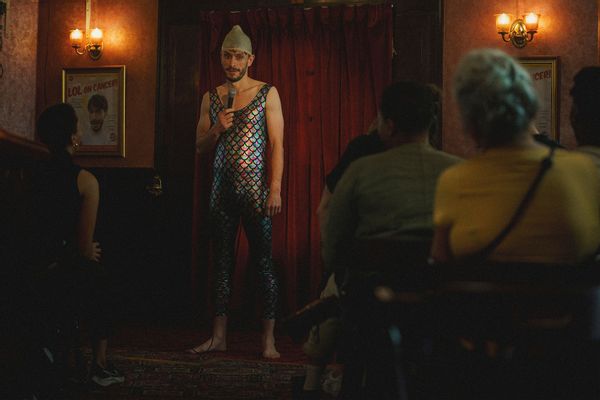
Yeah, it was close. I think we took that element of that fun-ness, that youth. There was that element of Richard there, the true Richard there.
What was the process like of trying to find the right sparkly unitard, for example?
It was a big prep day. It was like I think two days we did with Richard — the back-and-forth of finding uni sizes. The main thing for that was finding the right colors and finding the right fit. So it was just ordering those different things online, finding them in the charity stores, trying to find the right texture, breaking it down. When we found this one, straightaway was like, "This is it. This is the color." And I think it's because it's got the iridescence to it as well. It plays on the different colors and different ways light shines upon it.
I was gonna say it almost looks like fish scales. I don't know if you've ever read the book "Rainbow Fish"? It was a big children's book in America when I was growing up. Basically, it's those same iridescent fish scales. That's exactly what it made me think of when I saw Donny's costume.
It's also meant to be like, Donny never had money yet. He wasn't this rich person, so all of his costumes or his outfits he would have had in his wardrobe would have just been things that he would have found at the cheapest store or anywhere just like in the market. So again, it had to say true to that character, true to that British-ness as well, and true to that culture.
When the audience meets Donny again in the present day at the bar, he's kind of dressed pretty drably and kind of plain. What were the conversations there? Was that deliberate?
Yes, all the like the pub scenes. So you see kind of two stages with Donny: You see first the crewneck t-shirts and that's quite younger or when it's underneath the shirts or checked shirts. But when he's in the pub, the polo with the collar — that's supposed to represent that boy who's trying to be that man. He's trying to be with the other guys. He's trying to live up to that. So it's just that very British lads attire, you know, "Feel like you're the man especially when you're a young man." You want to feel like the rest of the boys what most do and what fit in you don't want to stand out or feel left out
Again, and it's funny because most of those polos were either from charity shops. One of my best mates, he had a bag of these old t-shirts that he just had sitting in his wardrobe for years and I'm like, "Perfect!" Everything had to look as worn in as used as possible because again, Donny doesn't have money to buy things every day. But again the colors were so right as well — the burgundy is deep red, these greens are saturated greens.
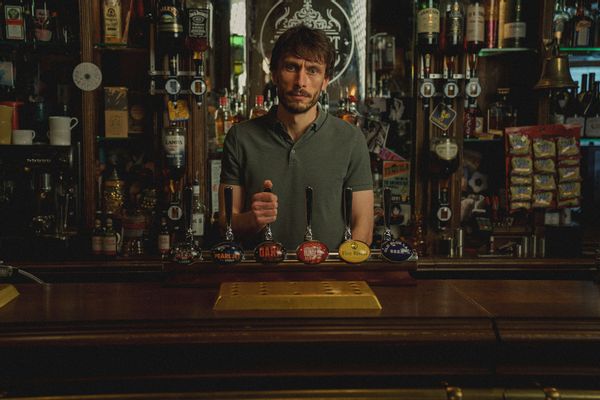
So I thankfully had four months of prep initially. It wasn't meant to be four months. It was meant to be six weeks. So due to other reasons to do like this things getting delayed. That's what gave me all that time, and it was a process . . . Jessica — she's a UK size 24, and when you go to a charity store, you're not going to find a whole rail of everything available. You might find one or two and then, "Oh, it's blue or oh, it's yellow." So I work into a color palette as well. So it was then also like, having to eliminate. And it just took patience. I think by having that extra prep that time it took me time again just to go through different areas and understand the different demographic areas of London. When it's a more affluent area, you're gonna get certain body shapes.
Yeah, it was just amazing just to go to charity shops and just to appreciate the secondhandedness of it, the sustainability, and what that does for the world — the impact it also had on the budget. It all had just a domino effect.
Was the decision to source from secondhand shops a directive or is that something you did on your own? Secondly, how much if at all was sustainability sort of factored into that decision?
I made the decision straight away to the team that it had to be done by secondhand charity shops. Some of the stuff was even from my gran's wardrobe, from friends. I was going around different friends saying, "Any old clothes you have let's just give them to me."
Did you say your granddad's wardrobe?
My grandma. Yeah. Cardigans and some of Martha's nighties are actually my gran's old stuff.
Wow, that's so cool. How did she feel about seeing her clothes on screen?
Well, sadly my gran's in a home with dementia, but we still had the family home where some of our stuff is. And I asked my mom and my aunts if it was OK if they gave me some stuff. And yeah, Jess [Gunning] really loved the depth of what I did there as well with that. Yeah, that was really special to Jess.
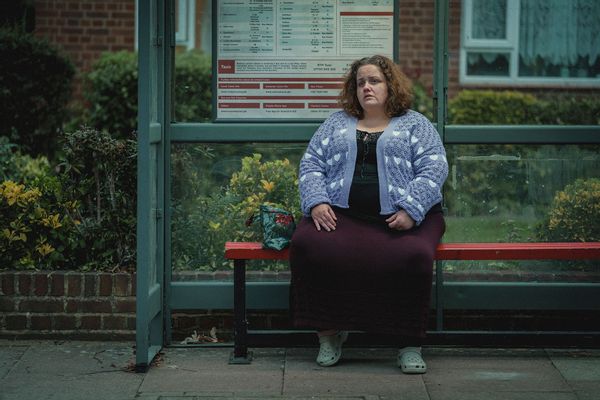
Regarding sustainability, it wasn't done with the idea of me trying to be so green or trying to think of saving the planet. I just wanted to get the job done and that was the only way. So with that in tow, it then did become us being green and making a huge offset in that way. And I think that also showed production a different way to work, It inspired the team in a different way. And again, it was just an extra challenge — more patience.
You've mentioned on your social media that those sorts of slight imperfections in pre-worn clothes added a certain depth, especially to characters like Martha. How important was it to you to have Martha's inner world and struggles reflected in her attire?
Martha, for me, was the best character I've ever created. Just in trying to understand where her mind was at. It had to be chaotic; but still, there is this somewhat put-togetherness: She still makes the effort, she puts her makeup on, she does her hair. But it still doesn't quite work. It doesn't quite flow. And with that it was all about making sure there was this feeling that's quite sad. I feel actually when you think about Martha, it really is sad because it's never trying to make a mockery of the real person. It's never trying to body shame, although by all those things sometimes come out in those outfits. The tightness of it, the awkwardness of it, the print clashing . . . it doesn't make sense.
You see the predator side of Martha come up when we play with animal prints. And then when she's all dolled up or she thinks that things are going good, you see these pinks and the lilac and the greens more when she's happy. And then when she's very sad, you see her at the bus stop in a gray purple. And then you see the polka dot dress when she fights — she's angry now, so there's these spots of anger. We also played with her bags — you see flowers on them a lot which brings her back to her youth and her childhood. So there are a lot of deeper connotations of Martha.
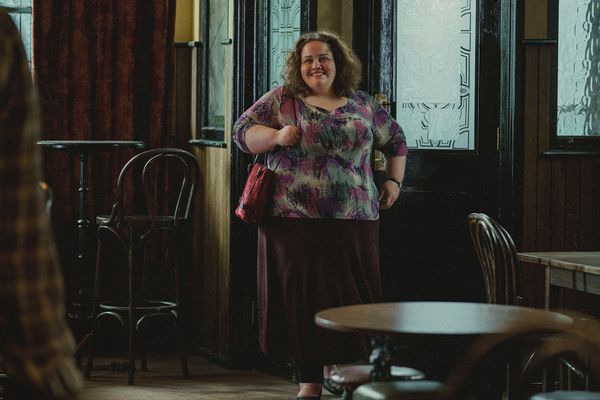
There isn't a word to describe it. It doesn't go together, it's not cohesive. It's like she holds on to her past life and doesn't quite know how to move on from that. It's everything that is old that she's had for years. There's nothing too new. She tries her best to reinvent each time differently but it's just still the same stuff. So it's kind of like a time warp. She realized that her body has changed but she's still stuck in the same clothes that she used to wear when she was part of another time.
I'd love to talk about Teri – Donny's on-and-off girlfriend – as well, who is one of my favorite characters from the show. We see her in colorful dresses and fun prints. Correct me if I'm wrong, but perhaps this symbolizes the sort of fun and levity she brings to Donny during an especially dark time in his life.
Yeah, indeed. So especially when you first meet her in the flashback, she's wearing that very green lime green crop top. So straight away you're like, "Whoa, who's this? Where's this color coming from? Who is this energy of life that's sparked up his life and gives him joy?" So in all of those moments, she's this energy for him, but a good energy. She's someone who excites his life and that is purposely done through the outfits chosen.
Finding Nava's [Mau] costumes was sort of the same process.
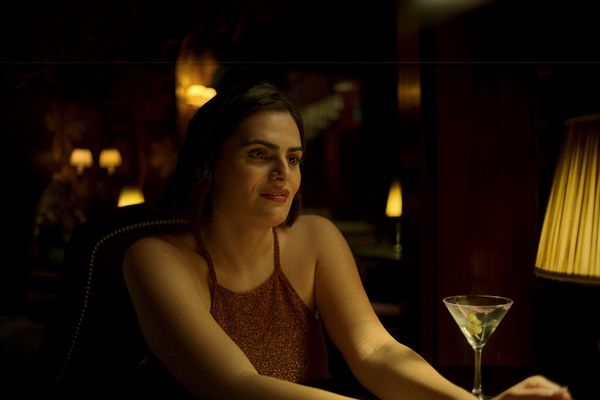
Nava is an amazing person in general. I really connected with Nava on so many levels, especially because she's a trans person — I'm a gay man myself. So we connect at that level as well; we both are part of the LGBTQI+ community.
Making her feel comfortable was one key thing for me. And with that she then becomes even more confident. Being aware of her body, being aware of her shape, being aware of all of her insecurities that we all have as human beings. It was about, "How can we empower that instead of play into that or make that an insecurity and less empowered?"
So from the beginning process with Nava was, "Let's try this on. Let's go through all the different shapes: crop-tops, high necks, low necks, halter necks. All the different shapes of what works for you, what works for your body, what you don't like, what you do like." And then once we found that, we started to play on the colors again. This time we were more fun, with more young and vibrant tones. There was this kind of baby girl, baby doll, sexy kind of cheeky essence little skirts and showing a bit of leg. So there was still that fun-ness with Nava and Teri that we got to play around with.
You've been working as a costume designer for some time now. How would you say "Baby Reindeer" differed from past projects that you've worked on, both in content and the technical aspects of getting ready for it?
This is probably my biggest job in every way. The length, the crew, the cost, in every plot in every medium I feel of working as a costume designer. This definitely has pushed my skills, pushed my learning, pushed my creativity. In every way it's challenged me, but in a great way. Do you know I mean? Working in such a raw way with a story – I've been able to tell someone's story through this narrative and through the costume. Working alongside Clerkenwell [Films] and on Netflix with the producer Matthew Mulot and Richard himself. Working with the color palettes – it was so intense. It wasn't a very surface thing. There’s such depth to it, and, I think, one of the most amazing things about working on “Baby Reindeer.”
We're all working together cohesively on this project, which I think, as you said, made it a well-made show.
I want to turn back to Donny for my last question. Obviously, this show is hugely emotionally complex and I think one of its biggest successes is the way that it shows the sort of nonlinear effects of trauma. What was it like when you finally watched the show as a viewer and saw Donny on stage in that plaid suit during that absolutely heart-rending scene where he confesses the abuse he endures as well as Martha's stalking with his audience? Did it have the impact that you expected?
If I'm entirely honest the first that I watched it, it actually brought a tear to my eyes. It definitely welled me up a bit. I found it very emotional — but in such a beautiful way. I mean I'm all about sincerity and honesty and I commend Richard so much. I think he's just amazing. To bare your truth to the world on such a huge platform is outstanding.
Seeing it [the scene] now, once it was edited and put together — it's still that raw emotion every time. Then I guess even just adding the costume to it only amplifies it as well. Just the tone of it and seeing someone in that suit and that state and just seeing that spotlight. It was a very powerful, emotive scene.
"Baby Reindeer" is streaming now on Netflix.







